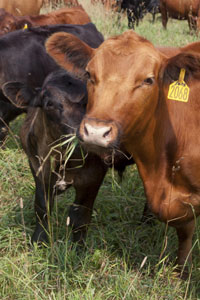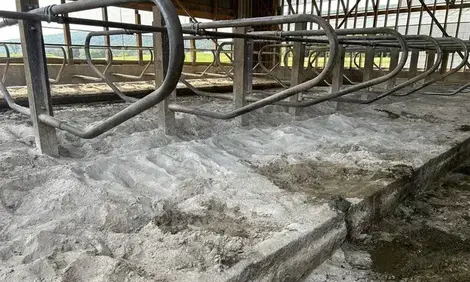



Beef Production: Insights on Carbon, Methane and Feeding the Future
Today’s climate change conversation often references gains in carbon emissions without discussing the source and function of the emission, writes Javier Martín-Tereso, Manager Ruminant Research Centre at Trouw Nutrition, a Nutreco company. This article is the second in a two-part series that looks at how beef cattle can support responsible food production. In the previous article, we examined how grazing beef cattle are innately suited to utilize land resources. Below, we look at the oft-discussed issues surrounding food production and climate change.
This article is the second in a two-part series that looks at how beef cattle can support responsible food production. In the previous article, we examined how grazing beef cattle are innately suited to utilize land resources. Below, we look at the oft-discussed issues surrounding food production and climate change.
 Fossil fuels stem from geologic reserves used for fuel energy, whereas emissions from cattle are released after being captured by a plant and transformed into atmospheric carbon. As such, emissions from cows are naturally integrated into the entire ecosystem as part of a short-term carbon cycle that includes fluxes between soil, oceans, plants and the atmosphere. The relevance of cattle in this cycle is the conversion of carbon into its methane form. Even if this carbon form is short lived in the atmosphere, it is very relevant in its greenhouse effect.
Fossil fuels stem from geologic reserves used for fuel energy, whereas emissions from cattle are released after being captured by a plant and transformed into atmospheric carbon. As such, emissions from cows are naturally integrated into the entire ecosystem as part of a short-term carbon cycle that includes fluxes between soil, oceans, plants and the atmosphere. The relevance of cattle in this cycle is the conversion of carbon into its methane form. Even if this carbon form is short lived in the atmosphere, it is very relevant in its greenhouse effect.
While much attention is focused on carbon in the atmosphere, the vast amounts of carbon stored in the soil as well as in the oceans are often overlooked. And while much progress needs to be made to reduce carbon emissions, the goal is not to eliminate emissions entirely, but to restore an equilibrium in this carbon cycle. This complex system seems to have adapted to the stress induced by human activity.
Photosynthesis has increased and the uptake of carbon by the ocean has increased but these adaptations cannot cope with the current level of emissions. An observation of the carbon balances describes the severity of the problem, but it also describes an opportunity to restore balance by indispensable emission reduction. Most importantly, perspective on carbon stores and fluxes exposes an urgent need to observe soil and oceanic carbon preservation, as a positive opportunity but also as a threat deserving greater awareness.
Similarly, atmospheric methane needs understanding as a natural component of the atmosphere that has lost its equilibrium due to human activity. Beyond domestic ruminants, methane emissions include fossil fuel activities and many natural sources such as wild ruminants, wetlands, soil releases and natural geological emissions from volcanos. Also, in the case of methane, different forms of capture or oxidation should compensate all these emissions, but this balance has been lost and atmospheric methane concentrations are currently rising dangerously. However, the estimated excess methane emission is rather small as compared with total emissions and drains and as compared to emissions related to human activity. In fact, the excess is about 10% of fossil fuel or domestic ruminant emissions. This suggests an optimistic opportunity to restore balance by emissions or either or both of those sources.
Estimating the potential global warming effect resulting from methane emissions is far from simple. The greater heat capture value of methane as compared to carbon dioxide is well described, and it is generally accepted that methane has a warming potential 30 times that of carbon dioxide. This value results from the known warming potential and the expected time until it is converted to carbon dioxide, but different values result from different time horizons of climate change.
Recent research from the Oxford Martin School dives deeper into this calculation estimating outcomes under conditions of rising, constant, or declining methane emissions. This newly suggested approach suggests an optimistic impact from scenarios of small decreases in emissions, which would result in greater than earlier expected mitigation of global warming, encouraging efforts to mitigate methane emissions.
When it comes to mitigating greenhouse gases, it is important to remember that methane is a by-product of beef cattle’s digestion as opposed to its meat production. Thus, the methane footprint of meat production is strongly associated with feed efficiency. Additional efforts to reduce methane emissions by nutritional means are also interesting but should not distract from the main opportunity for mitigation, which is increasing the feed efficiency of beef animals.

The Evolving Role of Beef Cattle
Ruminants have been a part of food production since the inception of agricultural practices. As the world’s population demands growth in food quantity and quality, the natural upcycling abilities of beef cattle will help meet protein demand. Cattle will also support the responsible use of agricultural technologies that have allowed cropland to vastly increase productivity. By balancing efforts between intensification with integration in natural landscapes for beef cattle, nutritional technologies and practices can bring greater efficiency to protein production.
Adaptations to grazing cattle nutrition and management can play a key role in integrated approaches to mitigating greenhouse gases. Reducing the carbon footprint of food production will require a holistic approach blending nutritional and ecological solutions. As highly efficient sources of high-quality protein, beef cattle are integral parts of feeding the future.


